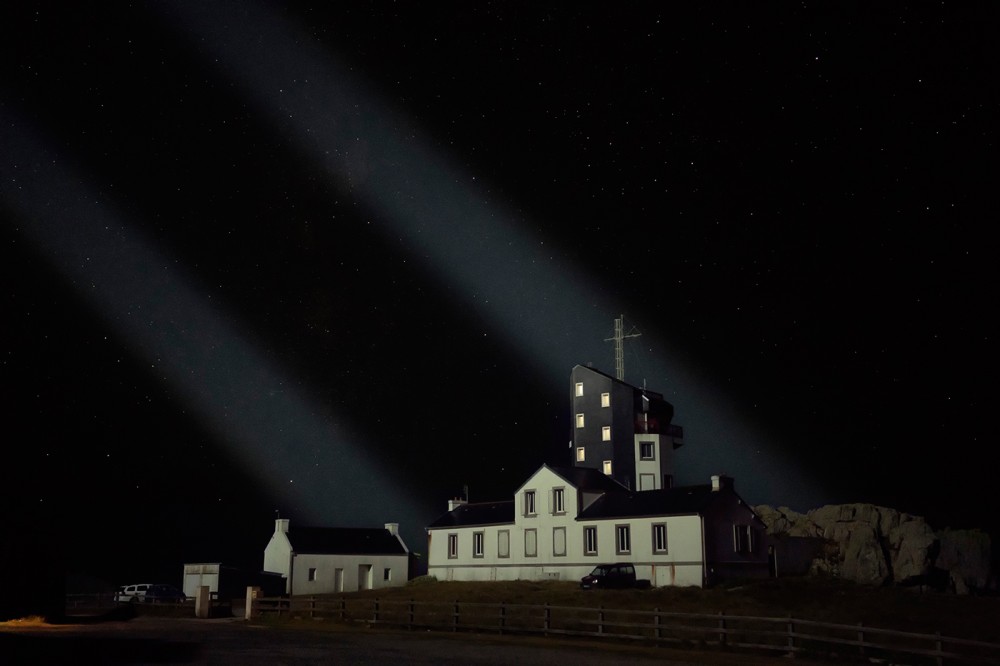Capucine Vever
SEMAPHORE RESIDENCY#23
A retreat residency, connected to the context of the Créac’h lighthouse on Ouessant.
Ouessant











SEMAPHORE RESIDENCY#23
A retreat residency, connected to the context of the Créac’h lighthouse on Ouessant.











Having the opportunity to reside for a month, alone, in a building whose very purpose was to carry (phoros) the sign (sema), facing the Atlantic Ocean, is undeniably a unique experience. Viewed from the semaphore, with the nearest land 3,550 kilometers away, the constancy of the horizon is simply dizzying—a line without thickness that holds the promise of infinity. It always keeps its distance, slipping away with every attempt to approach it. It is undeniably present but lacks materiality. The boundary traced by the horizon is imaginary, existing solely within the mind. In continuity with my research on the unattainable, the horizon appeared to me during this residency as a territory to explore.
By day, I spent countless hours at my observation post, in the watch room—this vigilant eye open to the sea. I devoted many hours to searching the ocean in vain for the hundreds of cargo ships passing daily just a few dozen miles ahead. Connected to real-time navigation sites, I had their precise locations, yet I was thwarted by their invisible presence. I found it absolutely fascinating that I could not see from the semaphore this relentless flow of goods and raw materials from around the globe, whose shipping routes had been pushed just beyond the horizon. Through a dissociation of image and sound, the film La Relève, shot exclusively from the semaphore (in July and for a few days in December 2018), plays on this contrast between highly contemplative images of the oceanic expanse—a shared vision of a pristine ocean—and a voice delivering factual descriptions of the intense activity taking place there, yet unseen. The narrator is off-screen, embodying the now-vanished figure of the lighthouse keeper. Like an acousmêtre (1)—a character that exists only in the sonic space of the film—her presence is designed to feel as though she might appear at any moment, unlike a voiceover, which is entirely external to the imagery. The minimal, meditative music by Valentin Ferré also plays a crucial role, echoing the repetition characteristic of maritime freight. These sound layers synchronize and desynchronize without any sonic connection to the images, except for subtle fragments. The voice focuses on delivering precise details about these cargo ships, the off-screen element of the landscape. While distance is omnipresent in the visuals, the narrator’s reflections lead us to consider it as nonexistent, erased by the relentless, low-cost flow of goods.
At night, when all activity on the island pauses, the plunge into darkness is complete, as Ouessant is free from light pollution. The horizon vanishes—this point of reference ceases to exist, retreating into the nocturnal depths. One day, in my presence, a magician removed the horizon all around me (10 years after Nicolas Floc’h) is a series of six photographs I created by pushing the camera sensor’s sensitivity to the extreme (up to 40,000 ISO)—the only way to freeze the Créac’h lighthouse beams in their continuous rotation. While the human eye perceives only a dark expanse swept by light as I press the shutter, the sensor’s hypersensitivity captures a dreamlike, vaporous landscape in under half a second. Multiple temporalities overlap; sunlight can appear in the photograph two hours before it is perceptible to the human eye. The noise level in these images lends them a pictorial depth and texture, revealing the density of the night on Ouessant. The subtitle 10 years after Nicolas Floc’h references the nighttime photographs made during the same residency by the artist a decade earlier, using a large-format camera—a radically different technique requiring long exposure times. The ten-year gap between our respective residencies highlights the technological advances in photography, where the lighthouse beams and landscapes are now captured in vastly different ways.
During this residency, I thus experienced two antithetical relationships to the horizon—one diurnal, one nocturnal—both the imaginary and the real, against which one collides, as Céline Flécheux so simply describes. A horizon I perceived as much as a space for mental projection as a political space.
*Capucine Vever
La Relève, 4K film, 14 min 36 sec, 2019
A film by Capucine Vever
Awards:
First Prize Video 2019 at OVNI Festival in Nice, supported by the Centre de la Haute Énergie.
Coproduction:
Association Finis Terrae and CNAP (with support for a first gallery exhibition).
Supported by:
Galerie Eric Mouchet
Credits:
Images, text, voice, and editing: Capucine Vever
Camera: Mathieu Pinard and Capucine Vever
Music and text proofreading: Valentin Ferré
Graphics and color grading: Mathieu PinardLanguage: French
Subtitles: English
Country of Production: France
Projection formats: DCP, Apple ProRes, MOV, 4K, HD